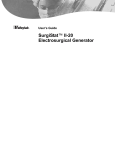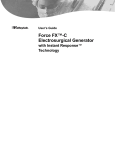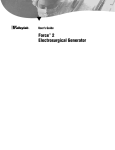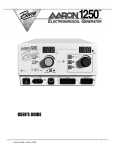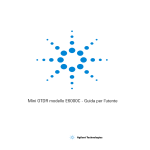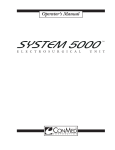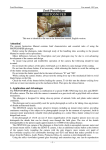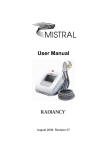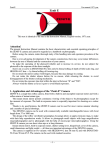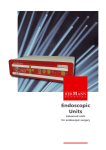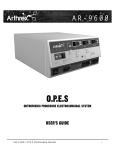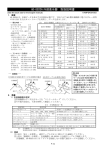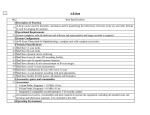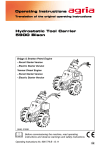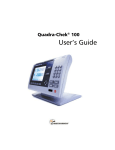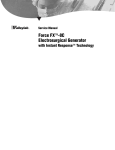Download Surgistat II coagulation Service Manual
Transcript
Service Manual SurgiStat™ II Electrosurgical Generator Preface This Service Manual and the equipment it describes are for qualified technicians who maintain the SurgiStat™ II Electrosurgical Generator. Additional user information is available in the SurgiStat™ II User’s Guide. This document covers technical descriptions of the SurgiStat™ II generator, including its physical appearance, all operator controls and indications, operational specifications, component functional descriptions (module level), diagrams of the electronic circuits used, and troubleshooting guidelines (with chart comparisons). The SurgiStat™ II was constructed with the highest quality components and was built in an ISO 9000 registered environment. In the unlikely event that your generator fails within one year of purchase date, Valleylab will warranty the product and effect factory repairs. Please refer to Section 8, Repair Policies and Procedures for what is covered, how long, and how to obtain a Return Authorization Number. Caution Federal (USA) laws restrict this device to sale by or on the order of a physician. Equipment covered in this manual SurgiStat™ II Electrosurgical Generator (120 VAC Model) Surg II-20 SurgiStat™ II Electrosurgical Generator (240 VAC Model) Surg II-8 SurgiStat™ II Electrosurgical Generator (100 VAC Model) Surg II-J Valleylab Part Number 1003626 Effective Date August 2006 Trademark acknowledgements Valleylab™, ForceTriad™, Force FX™, Force EZ™, Force Argon™, LigaSure™, LigaSmart™, Smart™, Cool-Tip™, TissuFect™, REM™, RFG-3C™, OptiMumm™, SurgiStat™, EDGE™, AccuVac™, PolyHesive™, and Instant Response™ are trademarks of Valleylab. Manufactured for Valleylab a division of Tyco Healthcare Group LP Boulder, Colorado 80301-3299 USA For information call 1-303-530-2300 European representative Tyco Healthcare UK Ltd. Gosport, PO13 0AS, UK Made in USA Printed in USA ©2006 Valleylab All rights reserved. ii SurgiStat II Service Manual Safety Precautions when Operating the Generator The safe and effective use of electrosurgery depends to a large degree on factors solely under the control of the operator. There is no substitute for a properly trained and vigilant medical staff. It is important that they read, understand, and follow the operating instructions supplied with this electrosurgical equipment. To promote the safe use of the SurgiStat II electrosurgical generator, please refer to the User’s Guide for standard operating precautions. Applicable Safety Standards CSA C22.2, NO. 601.1-M90 UL60601-1 IEC 60601-2-2 (1998-90) Class 1 Equipment, Type CF CENELEC EN 60601-1-2 FCC Part 15, Class A IEC 60601-1 2nd Edition (1988) Conventions Used in this Guide Warning Indicates a potentially hazardous situation which, if not avoided, could result in death or serious injury. Caution Indicates a hazardous situation which, if not avoided, may result in minor or moderate injury. Important Indicates an operating tip or maintenance suggestion. Notice Indicates a hazard that may result in product damage. SurgiStat II Service Manual iii Preface ..................................................................................................................................................................... ii Safety Precautions when Operating the Generator ......................................................................................... iii Applicable Safety Standards ................................................................................................................................ iii Section 1. The SurgiStat II Electrosurgical Generator Functional Description ......................................................................................................................................... 1-2 Unit Description .................................................................................................................................................... 1-3 Safety Precautions when Testing the Generator ............................................................................................ 1-3 General Warnings, Cautions, and Notices ............................................................................................. 1-3 Active Accessories ..................................................................................................................................... 1-4 Fire/Explosion Hazards ............................................................................................................................. 1-5 Generator Electric Shock Hazards .......................................................................................................... 1-5 Servicing ...................................................................................................................................................... 1-6 Cleaning ....................................................................................................................................................... 1-6 Section 2. Controls, Indicators, and Receptacles Front Panel............................................................................................................................................................ 2-2 Controls and Indicators Overview ..................................................................................................................... 2-3 Cut and Blend Controls ....................................................................................................................................... 2-4 Coag and Bipolar Controls ................................................................................................................................. 2-5 Indicators ............................................................................................................................................................... 2-6 Power Switch and Receptacles ......................................................................................................................... 2-7 Rear Panel ............................................................................................................................................................ 2-8 Symbols on the Front Panel ............................................................................................................................... 2-9 Section 3. Technical Specifications Performance Characteristics .............................................................................................................................. 3-2 Duty Cycle ................................................................................................................................................... 3-2 Dimensions and Weight ............................................................................................................................ 3-2 Operating Parameters ............................................................................................................................... 3-3 Transport and Storage............................................................................................................................... 3-3 Audio Volume .............................................................................................................................................. 3-3 Patient Return Electrode Sensing ........................................................................................................... 3-4 Low Frequency (50-60 Hz) Leakage Current ........................................................................................ 3-5 High Frequency (RF) Leakage Current .................................................................................................. 3-5 Standards and IEC Classifications .................................................................................................................... 3-5 Class I Equipment (IEC 60601-1) ............................................................................................................ 3-5 Type CF Equipment (IEC 60601-1)/Defibrillator Proof ......................................................................... 3-5 Electromagnetic Interference ................................................................................................................... 3-6 Voltage Transients (Emergency Generator Mains Transfer) .............................................................. 3-6 Electromagnetic Compatibility (IEC 60601-1-2 and IEC 60601-2-2) ................................................. 3-6 Output Power Characteristics .......................................................................................................................... 3-11 Maximum Output for Bipolar and Monopolar Modes .......................................................................... 3-11 Output Power Curves ........................................................................................................................................ 3-12 Reference Output Waveforms ................................................................................................................ 3-20 iv SurgiStat II Service Manual Section 4. Theory Of Operation Block Diagram ......................................................................................................................................................4-2 Functional Overview of Key Circuits .................................................................................................................4-2 High Voltage DC Supply ............................................................................................................................4-2 Low Voltage DC Supplies..........................................................................................................................4-2 DC Supply Check Circuit ...........................................................................................................................4-3 Temperature Sensing Circuit ....................................................................................................................4-3 Four Request Activation Sensing Circuits ..............................................................................................4-3 Speaker Circuit............................................................................................................................................4-3 Patient Return Electrode Sensing Circuit ...............................................................................................4-4 RF Amplifier Circuit ....................................................................................................................................4-4 Monopolar Select Circuit ...........................................................................................................................4-4 Monopolar/Bipolar Select Relays .............................................................................................................4-4 Controls and Indicators ..............................................................................................................................4-5 Digital PWM Circuit ....................................................................................................................................4-5 System Logic ........................................................................................................................................................4-5 SurgiStat II Control Signal Inputs and Outputs................................................................................................4-6 Section 5. Generator Operation Inspecting the Generator and Accessories ......................................................................................................5-2 Service Personnel Safety....................................................................................................................................5-2 Installation and Placement..................................................................................................................................5-3 Functional (Operational) Checks .......................................................................................................................5-3 How to Set Up and Start the SurgiStat II Unit ........................................................................................5-3 How to Check the Patient Return Electrode Alarm Function ...............................................................5-4 How to Check the Bipolar Mode (with Footswitch)................................................................................5-4 How to Check the Monopolar Mode (with Footswitch) .........................................................................5-4 How to Check the Monopolar Mode (with Handswitch)........................................................................5-5 Operating the Unit ................................................................................................................................................5-5 Section 6. Maintenance Cleaning the Unit ..................................................................................................................................................6-2 Performing Periodic Inspection ..........................................................................................................................6-2 Replacing Fuses ...................................................................................................................................................6-3 Section 7. Troubleshooting Recommended Equipment for Troubleshooting..............................................................................................7-2 Troubleshooting the SurgiStat II ........................................................................................................................7-2 Inspecting the Generator ...........................................................................................................................7-2 Inspecting the Receptacles .......................................................................................................................7-3 Understanding Error Codes and Audio Tones ................................................................................................7-4 Correcting Common Problems ...........................................................................................................................7-6 SurgiStat II Service Manual v Section 8. Repair Policy and Procedures Responsibility of the Manufacturer .................................................................................................................... 8-2 Returning the Generator for Service ................................................................................................................. 8-2 Obtain a Return Authorization Number................................................................................................... 8-2 Clean the Generator .................................................................................................................................. 8-3 Ship the Generator ..................................................................................................................................... 8-3 Service Center ...................................................................................................................................................... 8-3 Section 9. Warranty Section A. Board Drawings and Schematics Main Board ........................................................................................................................................................... A-3 Power Supply....................................................................................................................................................... A-4 RF Amplifier Circuit ............................................................................................................................................. A-5 Request Sense Circuit Hand A ......................................................................................................................... A-6 Request Sense Circuit Hand B ......................................................................................................................... A-7 Request Sense Circuit Foot A........................................................................................................................... A-8 Request Sense Circuit Foot B........................................................................................................................... A-9 Display Board .................................................................................................................................................... A-10 Display Logic ......................................................................................................................................................A-11 Monopolar Select Circuit .................................................................................................................................. A-12 Main Printed Circuit Board............................................................................................................................... A-13 Display Printed Circuit Boards ........................................................................................................................ A-14 Relay Printed Circuit Board ............................................................................................................................. A-15 Front Panel Assembly ...................................................................................................................................... A-16 Back Panel Assembly....................................................................................................................................... A-17 Final Assembly .................................................................................................................................................. A-18 vi SurgiStat II Service Manual SECTION 1 The SurgiStat II Electrosurgical Generator 1 This section includes the following information: • Key features • Components and accessories • Safety Caution Read all warnings, cautions, and instructions provided with this generator before using. Read the instructions, warnings, and cautions provided with electrosurgical accessories before using. Specific instructions are not included in this manual. SurgiStat II Service Manual 1-1 Functional Description The SurgiStat II is a multipurpose electrosurgical generator for use in physician’s offices and surgi-centers. It provides unsurpassed performance, flexibility, reliability, and user convenience in one compact package. The SurgiStat II generator includes digital technology. This new technology is evident in the self-checking circuitry and error code readouts. The unit offers monopolar and bipolar electrosurgical operations. The following are SurgiStat II key advantages and benefits. Power Capabilities Up to 120 watts (W) of Pure Cut @ 500 ohms (Ω). Up to 90 W of Blend @ 800 Ω. Up to 80 W of Desiccation @ 1000 Ω. Up to 40 W of Fulguration @ 1000 Ω. Up to 30 W of Bipolar @ 200 Ω. Two Levels of Coagulation: Desiccation and Fulguration Desiccation provides precise control of bleeding in localized areas. Fulguration provides greater control of bleeding in highly vascular tissue over broader tissue surface areas. Return Electrode Monitoring System The unit incorporates a return electrode contact quality monitoring system (RECQMS). This system determines the type of patient return electrode attached (single-plate or split-plate). It also continuously monitors the contact impedance between the patient and the split-plate patient return electode. Contact impedance is only monitored when approved split-plate patient return electrodes are used. 1-2 Memory The generator automatically powers up to the last modes selected, and previously set power settings. Isolated (Floating) Radio Frequency (RF) Output This minimizes the potential of alternate site burns. SurgiStat II Service Manual These connectors accept the latest monopolar and bipolar instruments. Self Diagnostics These diagnostics continually monitor the unit to ensure proper performance. The SurgiStat II Electrosurgical Generator Standard Front Panel Connectors Whenever they detect a problem, medical personnel receive audible and visual alarm responses, and the output is suspended until the alarm condition is cleared. Unit Description The SurgiStat II electrosurgical generator is a self-contained unit, consisting of the main enclosure and power cord. The main components incorporated in the generator are: • Front Panel Components Power switch, two dials for controlling power output, membrane switches for selecting modes, receptacles for connecting electrosurgical accessories, and indicators that show the current settings and patient return electrode status. • Rear Panel Components Volume control, footswitch receptacle, power cable receptacle and fuse holder, and equipotential grounding lug. • Internal Components Display board, main board, pad sensing module, speaker board, and relay board. Safety Precautions when Testing the Generator Before testing this generator it is important that you read, understand, and follow the instructions supplied with it. Also, be familiar with any other equipment used to install and test the generator. General Warnings, Cautions, and Notices Warning Use the generator only if the self-test has been completed as described. Otherwise, inaccurate power outputs may result. The instrument receptacles on this generator are designed to accept only one instrument at a time. Do not attempt to connect more than one instrument at a time into a given receptacle. Doing so will cause simultaneous activation of the instruments. SurgiStat II Service Manual 1-3 Caution Do not stack equipment on top of the generator or place the generator on top of electrical equipment. These configurations are unstable and/or do not allow adequate cooling. Provide as much distance as possible between the electrosurgical generator and other electronic equipment (such as monitors). An activated electrosurgical generator may cause electrical interference with them. Do not turn the activation tone down to an inaudible level. The activation tone alerts the surgical team when an accessory is active. Notice If required by local codes, connect the generator to the hospital equalization (grounding) connector with an equipotential cable. Connect the power cord to a wall receptacle having the correct voltage. Otherwise, product damage may result. Active Accessories Warning Electric Shock Hazard Do not connect wet accessories to the generator. Electric Shock Hazard Ensure that all accessories and adapters are correctly connected and that no metal is exposed. Caution Accessories must be connected to the proper receptacle type. In particular, bipolar accessories must be connected to the bipolar instrument receptacle only. Improper connection may result in inadvertent generator activation or a contact quality monitor alarm. Set power levels to the lowest setting before testing an accessory. Notice During bipolar electrosurgery, do not activate the generator until the forceps have made contact with the patient. Product damage may occur. 1-4 SurgiStat II Service Manual Warning Explosion Hazard Do not install the generator in the presence of flammable anesthetics, gases, liquids, or objects. Fire Hazard Do not place active accessories near or in contact with flammable materials (such as gauze or surgical drapes). Electrosurgical accessories that are activated or hot from use can cause a fire. Use a holster to hold electrosurgical accessories safely away from personnel and flammable materials. Fire Hazard Do not use extension cords. Fire Hazard For continued protection against fire hazard, replace fuses only with fuses of the same type and rating as the original fuse. Generator Electric Shock Hazards Warning Do not remove any covers or panels exposing the internal components. Refer to a Valleylab representative for service. Connect the generator power cord to a properly grounded receptacle. Do not use power plug adapters. Do not connect a wet power cord to the generator or to the wall receptacle. Always turn off and unplug the generator before cleaning. Do not touch any exposed wiring or conductive surfaces while the generator is disassembled and energized. Never wear a grounding strap when working on an energized generator. When taking troubleshooting measurements use appropriate precautions, such as using isolated tools and equipment, using the “one hand rule,” etc. Potentially lethal AC and DC voltages are present in the AC line circuitry, high voltage DC circuitry, and associated mounting and heat sink hardware described in this manual. These potentials are not isolated from the AC line. Take appropriate precautions when testing and troubleshooting this area of the generator. High frequency, high voltage signals that can cause severe burns are present in the RF output stage and in the associated mounting and heat sink hardware. Take appropriate precautions when testing and troubleshooting this area of the generator. SurgiStat II Service Manual 1-5 The SurgiStat II Electrosurgical Generator Fire/Explosion Hazards Servicing Caution Read all warnings, cautions, and instructions provided with this generator before testing. Notice There are no internal user serviceable parts. For repairs, return the generator to Valleylab. Cleaning Notice Do not clean the generator with abrasive cleaning or disinfectant compounds, solvents, or other materials that could scratch the panels or damage the generator. 1-6 SurgiStat II Service Manual SECTION 2 Controls, Indicators, and Receptacles 2 This section describes the front and rear panels, including all controls, indicators, receptacles, the fuse drawer, and ports. SurgiStat II Service Manual 2-1 Front Panel Figure 2-1.Layout of controls, indicators, and receptacles on the front panel 2-2 SurgiStat II Service Manual Controls and Indicators Overview Users may control most SurgiStat II functions from the front panel. Each control is plainly marked and colored on the front panel for quick reference. Volume control and a footswitch connector are on the rear panel. Normal operations involve activating the generator with either a front-connected handswitch OR a rear-connected footswitch. The following components are the user interface. The rocker ON/OFF switch on the lower left corner allows turning off the generator when the unit is not in use. Membrane Function Switches The front panel overlay contains six membrane function switches (sometimes called matrix switches). There is a membrane switch dedicated for each operational mode. These switches switch the unit between mode settings. Power Control Knobs These rotary knobs allow you to select the desired RF power level for all modes of operation. The power control knobs move in increments of one watt. Watts Display A & B (Cut and Coag) These large power output displays report the generator’s output power setting from 1 to 120 watts in one watt increments (at the rated load). During operation, the numeral output of the display gives the surgeon an indication of available generator power. Visual LED Indictors Mode LEDs indicate the mode setting. The YELLOW indicators and controls indicate cutting and blending operations. A yellow field LED indicates that either a Pure Cut or Blend mode is activated. The BLUE indicators and controls indicate desiccation, fulguration, and bipolar operation. The blue field LED indicates that either Desiccate, Fulgurate, or Bipolar mode is activated. The Footswitch Control LED Indicator indicates which mode the footswitch is presently in. Monopolar footswitch control allows the user to activate the monopolar mode when using footswitch controlled accessories. Bipolar footswitch control allows the user to activate the bipolar mode. A return electrode indicator displays which type of patient return electrode is attached to the patient. It also has an associated audio alarm that sounds when a patient return electrode is not detected during activation. Audible Indicators An activation tone sounds whenever the SurgiStat II Electrosurgical Generator is activated. The volume may be adjusted up or down on the rear of the unit. An alarm sounds during all alarm conditions. You cannot adjust the volume of this alarm. SurgiStat II Service Manual 2-3 Controls, Indicators, and Receptacles Power Switch Cut and Blend Controls Figure 2-2.Controls for the Cut and Blend modes Cut Indicator Illuminates when Pure Cut mode is selected. Cut Selector When pressed, selects the Pure Cut mode. Blend Selector When pressed, selects the Blend mode. Blend Indicator Illuminates when Blend mode is selected. 2-4 Cut and Blend Power Display (watts) Indicates the power set for the Pure Cut or Blend mode. Cut and Blend Activation Indicator Illuminates when either Pure Cut or Blend mode is activated. Cut and Blend Power Control Dial Increases or decreases the Cut or Blend power output in increments of one watt. SurgiStat II Service Manual Coag and Bipolar Controls Figure 2-3.Controls for the Desiccate, Fulgurate, and Bipolar modes Coag and Bipolar Activation Indicator Illuminates when Desiccate, Fulgurate, or Bipolar modes are activated. Desiccate Selector When pressed, selects the Desiccate mode. Fulgurate Indicator Illuminates when Fulgurate mode is selected. Fulgurate Selector When pressed, selects the Fulgurate mode. Bipolar Selector When pressed, selects the Bipolar mode. Bipolar Indicator Illuminates when Bipolar mode is selected. SurgiStat II Service Manual Coag and Bipolar Power Control Dial Increases or decreases the Coag or Bipolar power output in increments of one watt. 2-5 Controls, Indicators, and Receptacles Desiccate Indicator Illuminates when Desiccate mode is selected. Coag and Bipolar Power Display (watts) Indicates the power set for any Coag or Bipolar mode. Indicators Figure 2-4.Indicators for power, return electrodes, and footswitch control Bipolar Footswitch Control Indicator and Symbol Illuminates when bipolar foot control is selected. Patient Return Electrode Alarm Indicator Illuminates when the system detects a patient return electrode alarm condition. Power Indicator Illuminates when the unit is on. Split-Plate Patient Return Electrode Indicator Illuminates when the system detects a split-plate. 2-6 Monopolar Footswitch Control Indicator and Symbol Illuminates when monopolar foot Footswitch control is selected. Control Selector When pressed, Single-Plate Patient Return switches between Electrode Indicator monopolar and Illuminates when the system bipolar foot control. detects a single-plate. SurgiStat II Service Manual Power Switch and Receptacles Figure 2-5.Location of the unit power switch and front panel receptacles Controls, Indicators, and Receptacles Bipolar Receptacle Accepts standard cables for bipolar handpieces. Power On/Off Switch Turns the unit on or off. Patient Return Electrode Receptacle Accepts a standard patient return electrode plug. SurgiStat II Service Manual Monopolar Handswitching Receptacle Accepts standard three-pin handpieces. Connect handswitching accessories. Monopolar Footswitching Receptacle Accepts cables or adapters equipped with standard (Bovie #12) active plugs. Connect footswitching accessories. 2-7 Rear Panel Figure 2-6.Layout of connectors and controls on the rear panel Equipotential Connector Allows attaching a standard grounding cable to chassis ground for additional protection against leakage current. Footswitch Receptacle Accepts the E6008 or E6008B monopolar footswitch. Use the monopolar footswitch for both monopolar and bipolar activation. Use only a Valleylab monopolar footswitch with a SurgiStat II generator. Use of an incompatible footswith may cause unexpected output. 2-8 Volume Control Controls the volume of the audible tones produced during normal unit activation. To increase volume, rotate the knob clockwise. Power Cable Receptacle and Fuse Holder Connects a hospital grade power cord to supply AC mains power to the unit. Serial Number Label Specifies the unit model number, serial number, nominal line voltage, frequency, current, and power consumption. SurgiStat II Service Manual Symbols on the Front Panel Symbols Description Cut Controls Cut mode Blend mode Controls, Indicators, and Receptacles Coag Controls Desiccate mode Fulgurate mode Bipolar mode Indicators Single-plate patient return electrode Split-plate patient return electrode Monopolar footswitch control Footswitch (on the selector button) Bipolar footswitch control SurgiStat II Service Manual 2-9 Symbols Description Power Switch and Handpiece Connectors Read instructions before use Type CF equipment Patient return electrode F RF isolated – patient connections are isolated from earth at high frequency Caution – high voltage Monopolar output Bipolar output 2-10 SurgiStat II Service Manual Symbols on the Rear Panel Symbols on the Rear Panel Symbols Description Equipotential ground stud Nonionizing radiation Volume control Controls, Indicators, and Receptacles Danger Explosion risk if used with flammable anesthetics Monopolar footswitch Read instructions before use SurgiStat II Service Manual 2-11 2-12 SurgiStat II Service Manual SECTION 3 Technical Specifications 3 All specifications are nominal and subject to change without notice. A specification referred to as “typical” is within ± 20% of a stated value at room temperature (25° C / 77° F) and a nominal input power voltage. SurgiStat II Service Manual 3-1 Performance Characteristics Input Power Surg II-20 110–120 Volt Surg II-8 220–240 Volt Surg II-J 90–110 Volt Nominal input power voltage for calibration: 115 V Nominal input power voltage for calibration: 230 V Nominal input power voltage for calibration: 100 V Mains line frequency range (nominal): 50-60 Hz Mains line frequency range (nominal): 5060 Hz Mains line frequency range (nominal): 50-60 Hz Power consumption: 360 VA Power consumption: 360 VA Power consumption: 360 VA Fuses (2): 5A (Slow Blow) Fuses (2): 3.15A (Slow Blow) Fuses (2): 5A (Slow Blow) Duty Cycle Under maximum power settings and rated load conditions (Pure Cut, 120 W @ 500 Ω load), the generator is suitable for activation times of 10 seconds on, 30 seconds off for one hour. Notice The internal temperature of the unit is constantly being monitored. If the temperature rises above 85° C (185° F) an alarm sounds, the system displays an error code, and the system disables output power. Dimensions and Weight 3-2 Width 26 cm (10.25 in.) Depth 30.5 cm (12 in.) Height 15.2 cm (6 in.) Weight < 6.5 kg (< 14 lbs) SurgiStat II Service Manual Operating Parameters Ambient temperature range 10° to 40° C (50° to 104° F) Relative humidity 15% to 75%, noncondensing Atmospheric pressure 700 to 1060 millibars Warm-up time If transported or stored at temperatures outside the operating temperature range, allow one hour for the generator to reach room temperature before use. Transport and Storage Ambient temperature range -34° to 65° C (-29° to 149° F) Relative humidity 0% to 75%, noncondensing Atmospheric pressure 500 to 1060 millibars The audio levels stated below are for activation tones (bipolar, cut, and coag) and alarm tones (return electrode and system alarms) at a distance of one meter. Alarm tones meet the requirements for IEC 60601-2-2. Activation Tone Volume (adjustable) 45 to 65 dBA Frequency Cut: 1 kHz Blend: 1 kHz Desiccation: 2 kHz Fulguration: 2 kHz Bipolar: 2 kHz Duration SurgiStat II Service Manual Continuous while the generator is activated 3-3 Technical Specifications Audio Volume Alarm Tone Volume (not adjustable) 70 dBA ± 5 dBA Frequency 2 kHz for 1 second, then 1 kHz for 1 second Duration 4 seconds Patient Return Electrode Sensing Single-Plate Measurement current: < 100 µA Measurement frequency: 62.5 kHz ± 2.5 kHz Set resistance: 0 Ω to 5 Ω ± 3 Ω Continuous measurement: Once the system establishes the single-plate electrode resistance, an increase of 20 Ω ± 5 Ω in resistance will cause an alarm. When the alarm condition exists, the system deactivates output power. Split-Plate Measurement current: < 100 µA Measurement frequency: 62.5 kHz ± 2.5 kHz Set resistance: 10 Ω ± 5 Ω to 135 Ω ± 10 Ω Continuous measurement: Once the system establishes the split-plate electrode resistance, an increase of 40% in resistance or up to 150 Ω (whichever is less) will cause an alarm. A decrease of resistance below 4 Ω ± 2 Ω will cause an alarm. When the alarm condition exists, the system deactivates output power. The system presents audible and visible alarms when it does not sense a patient return electrode: 3-4 • When a fault condition occurs, the alarm indicator flashes red, an alarm tone sounds, and the system disables output power. • The red LED alarm indicator remains illuminated until you correct the condition that caused the alarm condition. • Activation attempts during an alarm condition result in an audio alarm and the alarm indicator flashes. • When the alarm condition is resolved, the green single or split-plate indicator will illuminate. • The system measures the return electrode sensing current according to IEC 60601-1. SurgiStat II Service Manual Low Frequency (50-60 Hz) Leakage Current Enclosure source current, ground open Source current, patient leads, all outputs < 300 µA 90V-110V mains voltage 110V-120V < 500 µA 220V-240V mains voltage Normal polarity, intact ground: < 10 µA Normal polarity, ground open: < 50 µA Reverse polarity, ground open: < 50 µA Sink current at high line, all inputs < 50 µA High Frequency (RF) Leakage Current Bipolar RF leakage current < 39 mArms Monopolar RF leakage current < 150 mArms The SurgiStat II generator meets all pertinent clauses of the IEC 60601-1 second edition and IEC 60601-2-2 third edition. Class I Equipment (IEC 60601-1) Accessible conductive parts cannot become live in the event of a basic insulation failure because of the way in which they are connected to the protective earth conductor. Type CF Equipment (IEC 60601-1)/Defibrillator Proof The SurgiStat II generator provides a high degree of protection against electric shock, particularly regarding allowable leakage currents. It is type CF isolated (floating) output and may be used for procedures involving the heart. SurgiStat II Service Manual 3-5 Technical Specifications Standards and IEC Classifications Liquid Spillage (IEC 60601-2-2 Clause 44.3) The SurgiStat II generator enclosure is constructed so that liquid spillage in normal use does not wet electrical insulation or other components which, when wetted, are likely to adversely affect the safety of the equipment. Electromagnetic Interference When placed on or beneath an activated Valleylab electrosurgical generator, the SurgiStat II generator operates without interference. The generator minimizes electromagnetic interference to video equipment used in the operating room. Voltage Transients (Emergency Generator Mains Transfer) The SurgiStat II generator operates in a safe manner when the transfer is made between line AC and an emergency generator voltage source. Electromagnetic Compatibility (IEC 60601-1-2 and IEC 60601-2-2) The SurgiStat II generator complies with the appropriate IEC 60601-1-2 and IEC 60601-2-2 specifications regarding electromagnetic compatibility. Notice The SurgiStat II should not be used adjacent to or stacked with equipment other than specified in the SurgiStat II User Guide and Service Manual. If adjacent or stacked use is necessary, the SurgiStat II should be observed to verify normal operation in the configuration in which it will be used. The SurgiStat II intentionally applies RF energy for diagnosis or treatment during activation. Observe other electronic medical equipment in the vicinity during the SurgiStat II activation for any possible adverse electromagnetic effects. Ensure adequate separation of electronic medical equipment based on observed reactions. The use of accessories, other than specified in the SurgiStat II User Guide and Service Manual, may result in increased emissions or decreased immunity of the SurgiStat II. 3-6 SurgiStat II Service Manual Guidance and manufacturer's declaration - electromagnetic emissions The SurgiStat II is intended for use in the electromagnetic environment specified below. The customer or the user of the SurgiStat II should ensure that it is used in such an environment. Emissions test Compliance Electromagnetic environment guidance RF emissions CISPR 11 Group 2 The SurgiStat II uses RF energy only for its internal function. Therefore, its RF emissions are very low and are not likely to cause any interference in nearby electronic equipment. RF emissions CISPR 11 Class A Harmonic emissions IEC 61000-3-2 Class A The SurgiStat II is suitable for use in all establishments other than domestic and those directly connected to the public low-voltage power supply network that supplies buildings used for domestic purposes. Voltage fluctuations/ flicker emissions IEC61000-3-3 Complies Technical Specifications SurgiStat II Service Manual 3-7 Guidance and manufacturer's declaration - electromagnetic immunity The SurgiStat II is intended for use in the electromagnetic environment specified below. The customer or the user of the SurgiStat II should assure that it is used in such an environment. Immunity test IEC 60601 test level Compliance level Electrostatic discharge (ESD) IEC 61000-4-2 +/-6 kV contact +/-6 kV contact +/-8 kV air +/-8 kV air Electrical fast transient/ burst IEC 61000-4-4 +/-2 kV for power supply lines +/-2 kV for power supply lines +/-1 kV for input/ output lines +/-1 kV for input/ output lines +/-1 kV differential mode +/-1 kV differential mode +/-2 kV common mode +/-2 kV common mode <5% Ut (>95% dip in Ut) for 0,5 cycle <5% Ut (>95% dip in Ut) for 0,5 cycle 40% Ut (>60% dip in Ut) for 5 cycles 40% Ut (>60% dip in Ut) for 5 cycles 70% Ut (>30% dip in Ut) for 25 cycles 70% Ut (>30% dip in Ut) for 25 cycles <5% Ut (>95% dip in Ut) for 5 sec <5% Ut (>95% dip in Ut) for 5 sec 3 A/m 3 A/m Surge IEC 61000-4-5 Voltage dips, short interruptions and voltage variations on power supply input lines IEC 61000-4-11 Power frequency (50/60 Hz) magnetic field IEC 61000-4-8 Electromagnetic environment guidance Floors should be wood, concrete or ceramic tile. If floors are covered with synthetic material, the relative humidity should be at least 30%. Mains power quality should be that of a typical commercial or hospital environment. Mains power quality should be that of a typical commercial or hospital environment. Mains power quality should be that of a typical commercial or hospital environment. If the user of the SurgiStat II requires continued operation during power mains interruptions, it is recommended that the SurgiStat II be powered from an uninterruptible power supply or a battery. Power frequency magnetic fields should be at levels characteristic of a typical location in a typical commercial or hospital environment. NOTE: Ut is the a.c. mains voltage prior to the application of the test level. 3-8 SurgiStat II Service Manual Guidance and manufacturer's declaration - electromagnetic immunity The SurgiStat II is intended for use in the electromagnetic environment specified below. The customer or the user of the SurgiStat II should assure that it is used in such an environment. Immunity test IEC 60601 test level Compliance level Electromagnetic environment guidance Portable and mobile RF communications equipment should be used no closer to any part of the SurgiStat II, including cables, than the recommended separation distance calculated from the equation applicable to the frequency of the transmitter. Conducted RF IEC 61000-4-6 3 Vrms 150KHz to 80MHz 3V Radiated RF IEC 61000-4-3 3 V/m 80MHz to 2.5GHz 3 V/m Recommended separation distance d=1.2√P d=1.2√P 80MHz to 800MHz d=2.3√P 800MHz to 2.5GHz Where P is the maximum output power rating of the transmitter in watts (W) according to the transmitter manufacturer and d is the recommended separation distance in meters (m). Interference may occur in the vicinity of equipment marked with the following symbol: NOTE 1 At a 80MHz and 800MHz, the higher frequency range applies. NOTE 2 These guidelines may not apply in all situations. Electromagnetic propagation is affected by absorption and reflection from structures, objects and people. a. Field strengths from fixed transmitters, such as base stations for radio (cellular/cordless) telephones and land mobile radios, amateur radio, AM and FM radio broadcast and TV broadcast cannot be predicted theoretically with accuracy. To assess the electromagnetic environment due to fixed RF transmitters, an electromagnetic site survey should be considered. If the measured field strength in the location in which the SurgiStat II is used exceeds the applicable RF compliance level above, the SurgiStat II should be observed to verify normal operation. If abnormal performance is observed, additional measures may be necessary, such as reorienting or relocating the SurgiStat II. b. Over the frequency range 150kHz to 80MHz, field strengths should be less than 3V/m. SurgiStat II Service Manual 3-9 Technical Specifications Field strengths from fixed RF transmitters, as determined by an electromagnetic site survey, should be less than the compliance level in each frequency range Recommended separation distances between portable and mobile RF communication equipment and the SurgiStat II The SurgiStat II is intended for use in an electromagnetic environment in which radiated RF disturbances are controlled. The Customer or the user of the SurgiStat II can help prevent electromagnetic interferences by maintaining a minimum distance between portable and mobile RF communications equipment (transmitters) and the SurgiStat II as recommended below, according to the maximum output power of the communications equipment. Separation distance according to frequency of transmitter (m) Rated maximum output power of transmitter (W) 150 kHz to 80MHz d=1.2√P 80MHz to 800MHz d=1.2√P 800MHz to 2.5GHz d=2.3√P 0.01 0.12 m 0.12 m 0.23 m 0.1 0.38 m 0.38 m 0.73 m 1 1.2 m 1.2 m 2.3 m 10 3.8 m 3.8 m 7.3 m 100 12 m 12 m 23 m For transmitters rated at a maximum output power not listed above, the recommended separation distance d in meters (m) can be estimated using the equation applicable to the frequency of the transmitter, where P is the maximum output power rating of the transmitter in watts (W) according to the transmitter manufacturer. NOTE 1 At a 80MHz and 800MHz, the separation distance for the higher frequency range applies. NOTE 2 These guidelines may not apply in all situations. Electromagnetic propagation is affected by absorption and reflection from structures, objects and people. 3-10 SurgiStat II Service Manual Output Power Characteristics Maximum Output for Bipolar and Monopolar Modes Power readouts agree with actual power into rated load to within 20% or 5 W, whichever is greater. All measurements were taken at the nominal input power voltage used for calibration. Output Power Output Frequency Repetition Rate Vp-p max Crest Factor* (Rated Load) Cut 120 W @ 500 Ω 357 kHz ± 50 kHz N/A 2.5 kV 2.9 ± 20% Blend 90 W @ 800 Ω 357 kHz ± 50 kHz 30 kHz ± 5 kHz 3.5 kV 3.3 ± 20% Desiccate 80 W @ 1000 Ω 475 kHz ± 50 kHz 57 kHz ± 5 kHz 4.5 kV 5.5 ± 20% Fulgurate 40 W @ 1000 Ω 410 kHz ± 50 kHz 25 kHz ± 5 kHz 6.5 kV 7.7 ± 20% Bipolar 30 W @ 200 Ω 520 kHz ± 50 kHz 32 kHz ± 5 kHz 2.0 kV 6.9 ± 20% Mode * An indication of a waveform’s ability to coagulate bleeders without a cutting effect Technical Specifications SurgiStat II Service Manual 3-11 Output Power Curves The curves that follow depict the changes for each mode at specific power settings. All measurements were taken at the nominal input power voltage used for calibration. Monopolar Cut Curves These measurements were taken using short (< 0.5 meter) leads. For each output power vs. impedance curve, the upper curve represents readings taken at full power; the lower curve, readings taken at half power. Output Power (watts) Figure 3-1 . Output power vs. impedance for Pure Cut mode Load Resistance (ohms) Open Circuit Peak Voltage (volts) Figure 3-2. Peak voltage vs. power setting for Pure Cut mode Output Power Setting (watts) 3-12 SurgiStat II Service Manual Figure 3-3. Output power vs. generator settings for Pure Cut mode 130 120 110 Output Power (watts) 100 90 80 70 60 50 40 30 20 10 0 0 5 10 15 20 25 30 35 40 45 50 55 60 65 70 75 80 85 90 95 100 105 110 115 120 Generator Setting Figure 3-4. Output power vs. impedance for Blend mode Output Power (watts) Technical Specifications Load Resistance (ohms) SurgiStat II Service Manual 3-13 Open Circuit Peak Voltage (volts) Figure 3-5. Peak voltage vs. power setting for Blend mode Output Power Setting (watts) Figure 3-6. Output power vs. generator settings for Blend mode 100 90 Output Power (watts) 80 70 60 50 40 30 20 10 0 0 5 10 15 20 25 30 35 40 45 50 55 60 65 70 75 80 85 90 Generator Setting 3-14 SurgiStat II Service Manual Monopolar Coag Curves These measurements were taken using short (< 0.5 meter) leads. Output Power (watts) Figure 3-7. Output power vs. impedance for Desiccate mode Load Resistance (ohms) SurgiStat II Service Manual Technical Specifications Open Circuit Peak Voltage (volts) Figure 3-8. Peak voltage vs. power setting for Desiccate mode Output Power Setting (watts) 3-15 Figure 3-9. Output power vs. generator settings for Desiccate mode 80 70 Output Power (watts) 60 50 40 30 20 10 0 0 5 10 15 20 25 30 35 40 45 50 55 60 65 70 75 80 Generator Setting Output Power (watts) Figure 3-10. Output power vs. impedance for Fulgurate mode Load Resistance (ohms) 3-16 SurgiStat II Service Manual Open Circuit Peak Voltage (volts) Figure 3-11. Peak voltage vs. power setting for Fulgurate mode Output Power Setting (watts) Figure 3-12. Output power vs. generator settings for Fulgurate mode 40 35 25 Technical Specifications Output Power (watts) 30 20 15 10 5 0 0 5 10 15 20 25 30 35 40 Generator Setting SurgiStat II Service Manual 3-17 Bipolar Curves Output Power (watts) Figure 3-13. Output power vs. impedance for Bipolar mode Load Resistance (ohms) Open Circuit Peak Voltage (volts) Figure 3-14. Peak voltage vs. power setting for Bipolar mode 3-18 Output Power Setting (watts) SurgiStat II Service Manual Figure 3-15. Output power vs. generator settings for Bipolar mode 30 Output Power (watts) 25 20 15 10 5 0 0 5 10 15 20 25 30 Generator Setting Technical Specifications SurgiStat II Service Manual 3-19 Reference Output Waveforms The following figures are the output waveforms as viewed on an oscilloscope. Figure 3-16. Pure Cut mode waveform Figure 3-17. Blend mode waveform 3-20 SurgiStat II Service Manual Figure 3-18. Desiccation mode waveform Figure 3-19. Fulguration mode waveform Technical Specifications SurgiStat II Service Manual 3-21 Figure 3-20. Bipolar mode waveform 3-22 SurgiStat II Service Manual SECTION 4 Theory Of Operation 1 This section includes the following information: • Block diagram • Functional overview of key circuits • System logic • Control signal inputs and outputs SurgiStat II Service Manual 4-1 Block Diagram Figure 4-1 . Functional block diagram of the SurgiStat II system Functional Overview of Key Circuits The following descriptions highlight the main circuits. High Voltage DC Supply The unit incorporates a high voltage power supply to generate the RF output power. The high voltage power supply delivers an unregulated DC output for the RF output. The nominal DC voltage from the high voltage power supply is 87 VDC ± 5 V. Low Voltage DC Supplies The unit incorporates four regulated low voltage levels to control generator operations. They are: 15 VDC, 12 VDC, 8 VDC, and 5 VDC. 4-2 • The 15 VDC circuit supplies power for all of the request sense circuits, the switching of the mode relays, and the audio circuit. • The 12 VDC circuit supplies power for the patient electrode sense module. • The 8 VDC circuit supplies power for the RF drive circuit. This circuit turns on and off the power MOSFETS for the RF output power. • The 5 VDC circuit supplies power for the logic system and all of the displays and indicators. SurgiStat II Service Manual DC Supply Check Circuit System logic uses the DC supply check circuit to monitor the high voltage DC supply. If the voltage increases by 30%, the system displays error code E4 and disables the RF output. For isolation purposes, the high voltage sense voltage is measured from the 15volt DC power supply. Temperature Sensing Circuit System logic uses the temperature sensing circuit to monitor the internal temperature of the unit. If the temperature rises above 85° C (185° F), the system displays error code E7 and disables the RF output. Four Request Activation Sensing Circuits System logic uses the activation request sensing circuit to detect both handcontrolled and foot-controlled activation requests. This circuit consists of a Colpitts Oscillator (operating at approximately 50 kHz) and a level detection circuit. In a nonactivation status, the Colpitts oscillator operates at its set operating frequency and presents a sine wave to the level detection circuit. The level detection circuit converts the sine wave into a square wave. Activation will not occur as long as a square wave is present. When a resistance (approximately 200 Ω or less) is presented to the transformer’s secondary winding by a hand-control or foot-control, the sense transformer is essentially shorted. The “short” is felt on the transformer’s primary winding, causing the Colpitts oscillator to temporarily shut down. When the oscillator shuts down, the sense signal becomes +5 VDC (logic “1”). This informs the system logic that a handswitch or footswitch activation request has been made. If the square wave (from any of the request sense circuits) is not present at the system logic when the unit is initially turned on, the system displays an error code, sounds an alarm, and disables RF output. Speaker Circuit Notice You cannot adjust alarm volume up or down. SurgiStat II Service Manual 4-3 Theory Of Operation System logic uses the audio circuit to generate activation tones and alarm tones. You can adjust volume for the activation tones from the back panel of the unit. Patient Return Electrode Sensing Circuit The patient return electrode sensing module senses and sends signals to the system logic, which displays which type of patient return electrode is attached to the patient. When you connect a single-plate patient return electrode to the unit, the pad sensing module will detect if the resistance is below 5 Ω. If it is, the SurgiStat II will display the green single-plate LED on the front of the unit. When you connect a split-plate patient return electrode to a patient and the pad sensing module detects a resistance between 10 and 135 Ω, then the SurgiStat II will display the green split-plate LED on the front of the unit. The pad sensing module constantly monitors the patient contact quality. If the impedance changes by a specific amount, then the unit displays an alarm and immediately deactivates the RF output power. Warning Patient return electrode contact quality is only monitored when a split-plate patient return electrode is attached to the patient. RF Amplifier Circuit The RF amplifier circuit generates the RF output energy that is delivered to the patient. It is a single-ended power amplifier, incorporating three power MOSFETs and two toroidal step-up transformers. The digital PWM circuit and the system logic unit generate the initial RF drive pulse. When the RF drive pulse turns the power MOSFETs “On,” current flows from the high voltage supply through one of the output transformers, depending on which mode the unit is in, through the clamping diodes, and then through the MOSFETs to high voltage ground. The energy developed by the “On” time is stored in an LC tank circuit. When the MOSFETs are off, the energy is delivered to the patient through the output capacitors. A longer “On” time develops more energy in the LC tank circuit; therefore, more energy is delivered to the patient. Monopolar Select Circuit The monopolar select circuit switches the SurgiStat II between each of the four monopolar modes. Matrix switches on the front panel allow mode selection. High voltage relays switch and isolate the four monopolar configurations. Monopolar/Bipolar Select Relays The monopolar / bipolar select relays change which output transformer is used to deliver the RF output to the patient. 4-4 SurgiStat II Service Manual Controls and Indicators The SurgiStat II uses the following controls and indicators: • Membrane switches These switches switch between modes. • Displays Seven segment displays indicate the output power in watts. • Mode indictors Green LEDs indicate the present mode of the unit. • Power control knobs These mechanical encoders adjust the output power for each mode. • Power switch A double pole single throw switch snaps into the front bezel. This switch supplies the AC mains current to the generator. Digital PWM Circuit The digital PWM circuit controls the output power of the unit. The system logic uses this digitally controlled signal to provide a precise signal to the RF drive. The power setting (generated by the user on the front of the unit) determines the pulse width. When the user sets the power, the system logic determines what the pulse width needs to be to deliver the requested output. System Logic The control logic uses a field programmable gate array as the generator “brain.” This system interprets all inputs and delivers the correct corresponding outputs. This system controls every operation of the unit. A system clock circuit, composed of an oscillator, provides the basic operating frequency of 5 MHz. The reset circuit provides a single pulse when you turn on the SurgiStat II generator. This pulse resets the field programmable gate array to ensure proper operation. Theory Of Operation SurgiStat II Service Manual 4-5 SurgiStat II Control Signal Inputs and Outputs The following table lists the important input and output signals. From a troubleshooting standpoint, the absence (and presence) of these signals will help you isolate problems. Signal Name Description PAD_SNS_ERROR This is the input signal from the pad sense module that informs the system logic that a pad sensing error has occurred. When a pad sense error occurs, a logic 1 (5 VDC) is sent to the system logic section. PAD_NSED This is an input signal from the pad sense module that informs the system logic that a single-plate patient return electrode is attached to the front jack strip. When the pad sense module senses the presence of a single-plate patient return electrode, a logic 0 (0 VDC) is sent to the system logic. PAD_SED This is an input signal from the pad sense module that informs the system logic that a split plate patient return electrode is attached to the patient. When the pad sense module senses the presence of a split-patient return electrode, a logic 0 (0 VDC) is sent to the system logic. AUD_DRV This is an output signal from the system logic that generates the activation tones for all modes of operation. A 1 kHz square wave is generated when the cut or blend mode is activated. A 2 kHz square wave is generated when the coagulation, fulguration, or bipolar mode is activated. This signal is used by the audio circuit. ALM_DRV This is an output signal from the system logic that generates a 2 kHz / 1 kHz square wave for activating the alarm siren. This signal is used by the audio circuit. 4-6 AUX_RLY_DRV This is an output signal from the system logic that controls the accessory relay on the back panel. TAP_SEL This is an output signal from the system logic that controls relays on the main board. The relays select which secondary windings will be used from the monopolar output transformer. SurgiStat II Service Manual Signal Name Description OUT_SEL This is an output signal from the system logic that controls relays on the main board. They control which output transformer provides the RF output circuit delivered to the patient. HAND/FOOT_SEL This is an output signal from the system logic that controls relays on the main board. These relays direct which output jack receives the output RF power. The output power for monopolar modes is switchable from foot-controlled handpiece activation to handcontrolled (switching pencil) activation. RF_DRV This is an output signal from the digital PWM circuit that controls the pulse width duration for the RF drive. CON_SENS This is an input signal that informs the system logic if the 24-pin ribbon cable (between the main board and the display board) is connected. When the cable is connected, a logic 0 (0 VDC) is sent to the system logic section. When the cable is damaged, not secure, or not connected, a logic 1 (5 VDC) is sent to the system logic. TEMP_SEN This is an input signal from the temperature sense circuit that informs the system logic if the internal temperature of the unit is above 85° C (185° F). If the internal temperature of the unit is below 85° C (185° F), a logic 1 (5 VDC) is sent to the system logic. If the internal temperature of the unit rises above 85° C (185° F), a logic 0 (0 VDC) is sent to the system logic. HV_SENS This is an input signal from the high voltage sense circuit that informs the system logic if a high voltage error has occurred. If the line voltage is within normal operating parameters, a logic 1 (5 VDC) is sent to the system logic. ACT_REQ_HAND_A This is an input signal from the hand A request sense circuit. hand A refers to the Cut button on the handpiece. A Colpitts oscillator located on the main board generates this signal. When an activation request occurs, this oscillator issues a logic 1 (5 VDC) signal. SurgiStat II Service Manual 4-7 Theory Of Operation If the line voltage increases by more than 30%, a logic 0 (0 VDC) is sent to the system logic. Signal Name Description ACT_REQ_HAND_B This is an input signal from the hand B request sense circuit. Hand B refers to the Coag button on the handpiece. A Colpitts oscillator located on the main board generates this signal. When an activation request occurs, this oscillator issues a logic 1 (5 VDC) signal. ACT_REQ_FOOT_A This is an input signal from the foot A request sense circuit. foot A refers to the Cut pedal on the footswitch. A Colpitts oscillator located on the main board generates this signal. When an activation request occurs, this oscillator issues a logic 1 (5 VDC) signal. ACT_REQ_FOOT_B This is an input signal from the foot B request sense circuit. foot B refers to the Coag pedal on the footswitch. A Colpitts oscillator located on the main board generates this signal. When an activation request occurs, this oscillator issues a logic 1 (5 VDC) signal. 4-8 SurgiStat II Service Manual SECTION 5 Generator Operation 1 This section covers the following topics: • Inspecting the generator and accessories • Service personnel safety • Installation and placement • Functional (operational) checks • Operating the unit SurgiStat II Service Manual 5-1 Inspecting the Generator and Accessories Before each use, inspect the unit and all accessories to verify good working order: • Inspect for physical damage to the generator and its connections. • Verify that the appropriate accessories and adapters are present. • Inspect all cords and connectors for signs of wear, damage, and abrasion. • Verify that the unit displays no error messages when turned on. Service Personnel Safety Warning Hazardous Electrical Output This equipment is for operational use only by a trained, licensed physician. Bio-med technicians must also exercise caution when testing a unit. Electric Shock Hazard Connect the generator power cord to a properly grounded receptacle. Do not use power plug adapters. Connect the power cord to a properly polarized and grounded power source with the frequency and voltage characteristics that match those listed on the back of the unit. Fire Hazard Do not use extension cords. Caution Do not stack equipment on top of the generator or place the generator on top of electrical equipment. These configurations are unstable and/or do not allow adequate cooling. Provide as much distance as possible between the electrosurgical generator and other electronic equipment (such as monitors). An activated electrosurgical generator may cause interference with them. Nonfunction of the generator may cause interruption of surgery. A backup electrosurgical generator should be available for use. Do not turn the activation tone down to an inaudible level. This activation tone alerts the surgical team when an accessory (and the generator) is active. When using a smoke evacuator in conjunction with the electrosurgical generator, place the smoke evacuator a distance away from the generator. Set the generator’s volume control (on the rear panel) at a level that ensures all activation tones may be heard. 5-2 SurgiStat II Service Manual If required by local codes, connect the generator to the hospital equalization connector with an equipotential cable. There is an equipotential connector on the rear of the unit. Connect the power cord to a wall outlet having the correct voltage. Otherwise, product damage may result. Installation and Placement Place the SurgiStat II Electrosurgical Generator on any flat surface with a tilt angle of not more than 10 degrees. The unit relies on natural convection cooling. Do not block the rear vents. Ensure that air flows freely on all sides of the unit. Warning Connect the power cord to a properly polarized and grounded power source with the frequency and voltage characteristics that match those listed on the back of the unit. Functional (Operational) Checks Upon initial installation of the unit, perform the following checks. Refer to the figures in Section 2, Controls, Indicators, and Receptacles, for the location of the controls and connectors. Caution At no time should you touch the active electrode or bipolar forceps. A serious burn could result. How to Set Up and Start the SurgiStat II Unit 1. Verify that the power switch is in the Off (O) position and that no accessories are connected to the unit. 2. Connect a hospital-grade power cable to the AC power cable receptacle on the back of the unit, then to a properly grounded wall outlet. 3. Connect a two-pedal footswitch to the matching footswitch receptacle on the back of the unit. Use only a Valleylab footswitch with the SurgiStat II generator. Although other types of footswitches may fit, they may not be compatible with this electrosurgical generator. Use of an incompatible footswitch may cause unexpected output. 4. Do not connect a patient return electrode to the front of the unit at this time. 5. Turn on the unit by switching the power switch to the On (|) position. 6. The correct startup for the unit is a quick flash of all indicators and a series of beeps. The unit will return to the last mode and power setting used. SurgiStat II Service Manual 5-3 Generator Operation Notice How to Check the Patient Return Electrode Alarm Function 1. Adjust the power settings for each mode (Pure Cut, Blend, Desiccation, Fulguration, and Bipolar) to 1 W. 2. Press the Cut pedal of the footswitch. 3. Verify that an alarm sounds for three seconds, and then the Patient Return Electrode Sensing Alarm Indicator light illuminates. This indicates the patient return electrode is not connected to the unit. 4. Verify that adjusting the volume control on the back of the unit (while the alarm is sounding) cannot change the alarm’s sound level. How to Check the Bipolar Mode (with Footswitch) 1. Select the Bipolar mode by pressing the Bipolar mode switch on the front panel. Note: The unit automatically changes to bipolar footswitching when you select the Bipolar mode. 2. Verify that the Bipolar mode LED illuminates green, and that the system generates the coag tone when you press the Coag pedal (blue) or the Cut pedal (yellow) on the footswitch. 3. While activating the Bipolar mode, rotate the volume control over the full range to verify that the sound is audible throughout the range. 4. Confirm that releasing the Coag pedal or Cut pedal returns the unit to an idle state. How to Check the Monopolar Mode (with Footswitch) 1. Select monopolar foot control by pressing the Footswitch Control Selector until the Monopolar Footswitch Control Indicator illuminates. 2. Connect a single-plate patient return electrode to the return electrode receptacle of the unit. Verify that the green single-plate patient return electrode indicator illuminates. 3. Press the Cut pedal on the footswitch. Verify that the Cut and Blend Activation Indicator illuminates and that the system generates the Cut activation tone. 4. While activating the Cut mode, rotate the volume control over the full range to verify that the sound is audible throughout the range. 5. Press the coag pedal on the footswitch. Verify that the Desiccate, Fulgurate, and Bipolar Activation Indicator illuminates and that the system generates the coagulation activation tone. 6. While activating the Coag mode, rotate the volume control over the full range to verify that the sound is audible throughout the range. 5-4 SurgiStat II Service Manual 1. Connect a handswitching handpiece to the Monopolar Handswitching receptacle. 2. Activate, one at a time, the Cut and Coag handswitching controls. Verify that each control causes the correct indicator and tone to sound. Operating the Unit Monopolar Cut Select the desired mode of operation (Pure Cut or Blend), then select the power settings by rotating the Cut and Blend Power Control Dial. Monopolar Coag Select the coag mode of operation (Desiccate or Fulgurate), then select the power setting by rotating the Coag and Bipolar Power Control Dial. Bipolar Select the mode of operation for Bipolar (coagulation or fulguration), then select the bipolar power settings by rotating the Coag and Bipolar Power Control Dial. Activate the generator by pressing the appropriate button on the handswitch or footswitch. Notice One footswitch can activate either monopolar or bipolar operation. Monopolar Operation To activate ... Pure Cut or Blend modes Desiccate or Fulgurate modes Press this ... On this device ... Yellow button Handswitching pencil Yellow or Cut pedal Footswitch Blue button Handswitching pencil Blue or Coag pedal Footswitch Bipolar Operation To activate ... Bipolar mode SurgiStat II Service Manual Press this ... Blue (Coag) or yellow (Cut) pedal On this device ... Footswitch 5-5 Generator Operation How to Check the Monopolar Mode (with Handswitch) 5-6 SurgiStat II Service Manual SECTION 6 Maintenance 1 This section includes the following information: • Cleaning the unit • Performing periodic inspection • Replacing fuses SurgiStat II Service Manual 6-1 Cleaning the Unit Warning Electric Shock Hazard Always turn off and unplug the generator before cleaning. Caution Do not allow fluids to enter the generator chassis. Do not sterilize the generator. Notice Do not clean the generator with abrasive cleaning or disinfectant compounds, solvents, or other materials that could scratch the panels or damage the generator. Clean the generator after each use. Follow the procedures approved by your institution or use a validated infection control procedure. 1. Turn off the generator. Unplug the power cord from the wall outlet. 2. Thoroughly wipe all surfaces of the generator and power cord with a mild cleaning solution or disinfectant and a damp cloth. Performing Periodic Inspection Every six months, visually inspect the generator for signs of wear or damage. In particular, look for any of the following problems: 6-2 • Damage to the power cord • Damage to the power cable receptacle • Obvious damage to the unit • Damage to any receptacle • Accumulation of lint or debris in or around the unit SurgiStat II Service Manual Replacing Fuses Fuses for the unit reside directly below the power cable receptacle on the rear of the unit. To replace the fuses, follow this procedure: 1. Unplug the power cord from the wall outlet. 2. Remove the power cord from the power cable receptacle on the rear panel. 3. To release the fuse Power Cable Receptacle drawer, insert a small flathead screwdriver into the slot on the drawer below the power cord receptacle. Then, slide the drawer out. 4. Remove the two fuses and Maintenance Fuse Drawer replace them with new fuses with the same values. 5. Insert the fuse drawer into the power cable receptacle. Use the following fuses: SurgiStat II Service Manual Surg II-20 110–120 V Surg II-8 220–240 V Surg II-J 90–110 V VAC 250 250 250 Amps 5.0 A 3.15 A 5.0 A Type Slow Blow Slow Blow Slow Blow Size 5 x 20 mm 5 x 20 mm 5 x 20 mm 6-3 6-4 SurgiStat II Service Manual SECTION 7 Troubleshooting 1 This section includes error code descriptions and actions to take to resolve them. SurgiStat II Service Manual 7-1 Recommended Equipment for Troubleshooting Use the following equipment to troubleshoot the SurgiStat II electrosurgical generator. • Digital multimeter with leads • Electrosurgical analyzer or a true RMS voltmeter, such as a Fluke 8920A • Wideband current transformer, such as a Pearson 4100 • Noninductive RF load resistors 200 Ω, 500 Ω, 800 Ω, 1000 Ω • Oscilloscope (dual channel) at 100 MHz • Oscilloscope probes, (2) 10X and 1000X • Valleylab footswitch • Valleylab handswitching pencil (single use or reusable) • Standard technician’s tool kit • Miscellaneous test leads and cables Troubleshooting the SurgiStat II If the generator is not functioning properly, use the information in this section to perform the following activities: • Identify and correct the malfunction. • If the system displayed an error code, take the appropriate action(s) to correct the error condition. Inspecting the Generator If the SurgiStat II malfunctions, check for obvious conditions that may have caused the problem. 1. Check the generator for visible signs of physical damage. 2. Verify that all accessory cords are properly connected. 3. Check the power cord. Replace the power cord if you find exposed wires, cracks, frayed insulation, or a damaged connector. 4. Open the fuse drawer and inspect the fuse housing and fuses for damage and corrosion. 5. Verify that the fuses are firmly seated. An internal component malfunction in the generator can damage the fuses. 6. You may need to replace the fuses if the generator fails the self-test or stops functioning. Refer to Fuse Replacement in Section 6. 7-2 SurgiStat II Service Manual Inspecting the Receptacles Equipment required: • Footswitch • Bipolar cable • Monopolar instruments (handswitch and footswitch) • Return electrode cable Procedure: 1. Turn off the generator. 2. Disconnect the power cord from the wall receptacle. 3. Check the footswitch receptacle on the rear of the unit for obvious signs of obstruction and damage. 4. Insert the footswitch connector into the footswitch receptacle. Check for a secure fit. Use only a Valleylab footswitch with the SurgiStat II generator. If the footswitch receptacle is damaged, contact your Valleylab Service Center. 5. Check the bipolar receptacle on the front of the unit for obstruction or damage. 6. Insert a bipolar cable into the bipolar receptacle on the front of the unit. Check for a secure fit. If the bipolar receptacle is damaged, contact your Valleylab Service Center. 7. Check the monopolar handpiece receptacle on the front of the unit for obstruction or damage. front of the unit. Check for a secure fit. If the monopolar handpiece receptacle is damaged, contact your Vallylab Service Center. 9. Check the monopolar foot-controlled receptacle on the front of the unit for obstruction or damage. 10. Insert a monopolar foot-controlled handpiece into the monopolar foot- controlled receptacle on the front of the unit. Check for a secure fit. If the monopolar foot controlled receptacle is damaged, Contact your Valleylab Service Center. 11. Check the patient return electrode receptacle on the front of the unit for a broken pin or an obstruction. 12. Insert a return electrode cable into the return electrode receptacle, and check for a secure fit. If the return electrode receptacle on the front of the unit is damaged, contact your Valleylab Service Center. SurgiStat II Service Manual 7-3 Troubleshooting 8. Insert a handswitching pencil into the monopolar handpiece receptacle on the Understanding Error Codes and Audio Tones The SurgiStat II Generator includes automatic, continual self-diagnostics. If the diagnostics detect an error, the system displays an error code, sounds an audible tone, and deactivates the output power. Any errors detected will shut down the RF output power. Notice Internal firmware self-diagnostics continually monitor unit operation to ensure proper and safe performance. Most error codes result from faults in accessories attached to the unit. The following table lists the error codes, describes the error, and recommends actions to take to resolve the error. Error Code Description Recommended Action F1 on the Cut/ Blend display Handswitch or monopolar footswitch cut pedal may be stuck F1 on the Desiccate/ Fulgurate/Bipolar display This is a start activation type of error and is the result of powering On while pressing the pencil activation button. Handswitch or monopolar footswitch coag pedal may be stuck 1. Turn off, then turn on the generator. Do not press buttons or accessory activation devices during the self-test. F2 Simultaneous activation error Cut and Coag buttons activated simultaneously (pencil or footswitch) The unit does not allow simultaneous activation of the Cut and Coagulation modes. Release either the Cut or Coag button on the handpiece, or the Cut or Coag pedal on the footswitch. F3 Foot activation error Monopolar handpiece activated while in Bipolar mode Release pressure on the handpiece buttons. Use the footswitch to activate bipolar, or switch to monopolar mode. E4 High voltage error Line voltage error (Line voltage too high; that is, the power supply is 30% above the nominal value) 1. Turn the unit off. 7-4 2. If the alarm number reappears, disconnect all accessories. Turn off, then turn on the generator again. 3. If the problem persists, replace the handpiece or footswitch and repeat Step 1. 4. If the alarm number reappears, record the number and contact your Valleylab Service Center. 2. Verify that the unit is connected to the correct line voltage. SurgiStat II Service Manual Error Code E5 Pulse width error Description Recommended Action Internal pulse width measurement exceeds setting requirements 1. Turn unit off. 2. If using a metal patient return electrode plate, verify that the cable connections are secure and replace cables with loose connections. Turn unit on. 3. If error code occurred directly after changing mode of operation, turn on the unit and delay activation of the accessories after changing mode of operation. 4. If alarm number reappears upon restarting the unit, record the number and call the Valleylab Service Center. E6 Delta check error Internal pulse width measurement conflicts with calibrated value 1. Turn unit off. 2. If error code occurred directly after changing mode of operation, turn on the unit and delay activation of the accessories after changing mode of operation. 3. If error code occurred directly after changing the power setting during activation, turn on the unit and limit the change of power to approximately three watts per second. 4. If alarm number reappears upon restarting the unit, record the number and call the Valleylab Service Center. E7 Temperature error Internal temperature of the unit exceeded limit 1. Turn the unit off. 2. Allow the unit to cool for 20 minutes. Troubleshooting 3. Restart the unit. E8 Connector sensing error caused by a sensed open circuit The 24-pin ribbon cable connected between the main board and the display board is either disconnected or damaged. SurgiStat II Service Manual Contact your Valleylab Service Center. 7-5 Correcting Common Problems If a solution is not readily apparent, use the table on the following page to help identify and correct specific malfunctions. After you correct the malfunction, verify that the generator successfully completes the self test. Situation Possible cause Recommended action Generator does not respond when turned on Disconnected power cord, faulty wall receptacle, or faulty power cord 1. Check power cord connections (generator and wall receptacle). 2. Connect the power cord to a functional wall receptacle. If necessary, replace the power cord. Fuse drawer is open or fuses blown 1. Close the fuse drawer. If necessary, replace the fuse(s). 2. If a problem persists, contact your Valleylab Service Center. Loose or disconnected internal cables Contact your Valleylab Service Center. Faulty power entry module or connections Faulty power switch Generator is on, but did not complete the self test Alarm condition exists Check the display for an error code. Note the number and refer to error code list. Loose or disconnected internal cables Contact your Valleylab Service Center. Faulty power switch Main board malfunction Display board malfunction Activation and/or alarm tones do not sound; speaker is malfunctioning Loose or damaged connection between speaker board and main board Contact your Valleylab Service Center. Loose or disconnected cable between main board and display board Main board malfunction Display board malfunction Blank or confusing LED display Faulty ribbon cable between main board and display board Contact your Valleylab Service Center. Display board malfunction 7-6 SurgiStat II Service Manual Situation Possible cause Recommended action Mode buttons do not operate correctly when pressed Loose or disconnected cable between main board and display board Contact your Valleylab Service Center. Loose or disconnected cable between front panel overlay and display board Damaged front panel overlay Generator is on and the accessory is activated, but generator does not deliver output Malfunctioning footswitch or handswitching instrument 1. Turn off the generator. Check and correct all accessory connections. 2. Turn on the generator. 3. Replace the accessory if it continues to malfunction. Display board malfunction Contact your Valleylab Service Center. Power set too low Increase the power setting. An error condition exists 1. Check the cut and coag displays for an error code number. 2. Note the number and refer to the error codes descriptions in this section. Main board malfunction Contact your Valleylab Service Center. Footswitch will not activate output Malfunctioning or damaged footswitch receptacle Troubleshooting RF output stage malfunction Contact your Valleylab Service Center. Footswitch activation signal lost on main board Incompatible footswitch SurgiStat II Service Manual Use only a Valleylab footswitch with the SurgiStat II generator. 7-7 Situation Possible cause Recommended action Continuous monitor interference Faulty chassis-to-ground connections 1. Check and correct the chassis ground connections for the monitor and, if applicable, for the generator. 2. Check other electrical equipment in the room for defective grounds. Electrical equipment is grounded to different objects rather than a common ground Plug all electrical equipment into line power at the same location. Generator may respond to the resulting voltage differences between grounded objects Interference with other devices only when generator is activated Malfunctioning monitor Replace the monitor. Metal-to-metal sparking Check all connections to the generator, patient return electrode, and accessories. High settings used for fulguration Use lower power settings for fulguration or select the Desiccate mode. Electrically inconsistent ground wires in the operating room Verify that all ground wires are as short as possible and go to the same grounded metal. If interference continues when the generator is activated, the monitor is responding to radiated frequencies Check with the manufacturer of the monitor. Some manufacturers offer RF choke filters for use in monitor leads. The filters reduce interference when the generator is activated and minimize the potential for an electrosurgical burn at the site of the monitor electrode. 7-8 SurgiStat II Service Manual Situation Possible cause Recommended action Pacemaker interference Intermittent connections or metal-tometal sparking 1. Check all connections to the generator. 2. It may be necessary to re-program the pacemaker. Current traveling from active to return electrode during monopolar electrosurgery is passing too close to pacemaker 1. Use bipolar instruments, if possible. If you must use a monopolar instrument, place the patient return electrode as close as possible to the surgical site. 2. Make sure the current path from the surgical site to the patient return electrode does not pass through the vicinity of the heart or the site where the pacemaker is implanted. 3. Always monitor patients with pacemakers during surgery and keep a defibrillator available. 4. Consult the pacemaker manufacturer or hospital. 5. Contact the Cardiology Department for further information when use of electrosurgical appliances is planned on patients with cardiac pacemakers. SurgiStat II Service Manual Metal-to-metal sparking Check all connections to the generator, patient return electrode, and active electrodes. Can occur during coag Use a lower power setting for the Fulgurate mode or select the Desiccate mode. Abnormal 50-60 Hz leakage currents Contact your Valleylab Service Center. Troubleshooting Abnormal neuromuscular stimulation (stop surgery immediately) 7-9 7-10 SurgiStat II Service Manual SECTION 8 Repair Policy and Procedures 1 This section contains the following information: • The manufacturer’s responsibility • Returning the generator for service SurgiStat II Service Manual 8-1 Responsibility of the Manufacturer Valleylab is responsible for the safety, reliability, performance, and service of the generator only under the following circumstances: • The user has followed the installation and setup procedures in this manual. • Persons authorized by Valleylab performed assembly operation, readjustments, modifications, or repairs. • The electrical installation of the relevant room complies with local codes and regulatory requirements, such as IEC and BSI. • Equipment use is in accordance with the Valleylab instructions for use. For warranty information, refer to Section 9, Warranty. Returning the Generator for Service Before you return the generator, call your Valleylab representative for assistance. If instructed to send the generator to Valleylab, first obtain a Return Authorization Number. Then, clean the generator and ship it to Valleylab for service. Obtain a Return Authorization Number Call the Valleylab Customer Service Center for your area to obtain a Return Authorization Number. Have the following information ready when you call: 8-2 • Hospital/clinic name/customer number • Telephone number • Department/address, city, state, and zip code • Model number • Serial number • Description of the problem • Type of repair to be done SurgiStat II Service Manual Clean the Generator Warning Electric Shock Hazard Always turn off and unplug the generator before cleaning. Caution Do not allow fluids to enter the chassis. Do not attempt to sterilize the generator. Notice Do not clean the generator with abrasive cleaning or disinfectant compounds, solvents, or other materials that could scratch the panels or damage the generator. 1. Turn off the generator, and unplug the power cord from the wall outlet. 2. Thoroughly wipe all surfaces of the generator and power cord with a mild cleaning solution or disinfectant and a damp cloth. Follow the procedures approved by your institution or use a validated infection control procedure. Ship the Generator 1. Attach a tag to the generator that includes the return authorization number and the information (hospital, phone number, etc.) listed in Obtain a Return Authorization Number. 2. Be sure the generator is completely dry before you pack it for shipment. Package it in its original shipping container. If the original shipping container is not available, request one when obtaining your Return Authorization Number. 3. Ship the generator, prepaid, to the Valleylab Service Center. Service Center Repair Policy and Procedures For a complete list of service centers worldwide, please refer to the Valleylab website: http://www.valleylab.com/valleylab/international/service-world.html SurgiStat II Service Manual 8-3 8-4 SurgiStat II Service Manual SECTION 9 Warranty 2 Valleylab, a division of Tyco Healthcare Group LP, warrants each product manufactured by it to be free from defects in material and workmanship under normal use and service for the period(s) set forth below. Valleylab’s obligation under this warranty is limited to the repair or replacement, at its sole option, of any product, or part thereof, which has been returned to it or its Distributor within the applicable time period shown below after delivery of the product to the original purchaser, and which examination discloses, to Valleylab’s satisfaction, that the product is defective. This warranty does not apply to any product, or part thereof, which has been repaired or altered outside Valleylab’s factory in a way so as, in Valleylab’s judgment, to affect its stability or reliability, or which has been subjected to misuse, neglect, or accident. The warranty periods for Valleylab products are as follows: SurgiStat II Service Manual ForceTriad Energy Platform One year from date of shipment Electrosurgical Generators One year from date of shipment RFG-3C Plus Lesion Generator One year from date of shipment LigaSure Vessel Sealing System One year from date of shipment LigaSure Reusable Instruments One year from date of shipment Mounting Fixtures (all models) One year from date of shipment Footswitches (all models) One year from date of shipment Force Argon Units One year from date of shipment OptiMumm Smoke Evacuator Two years from date of shipment LigaSure Sterile Single Use Items Sterility only as stated on packaging Sterile Single Use Items Sterility only as stated on packaging Patient Return Electrodes Shelf life only as stated on packaging 9-1 This warranty is in lieu of all other warranties, express or implied, including without limitation, the warranties of merchantability and fitness for a particular purpose, and of all other obligations or liabilities on the part of Valleylab. Valleylab neither assumes nor authorizes any other person to assume for it any other liability in connection with the sale or use of any of Valleylab’s products. Notwithstanding any other provision herein or in any other document or communication, Valleylab’s liability with respect to this agreement and products sold hereunder shall be limited to the aggregate purchase price for the goods sold by Valleylab to the customer. There are no warranties which extend beyond the terms hereof. Valleylab disclaims any liability hereunder or elsewhere in connection with the sale of this product, for indirect or consequential damages. This warranty and the rights and obligations hereunder shall be construed under and governed by the laws of the State of Colorado, USA. The sole forum for resolving disputes arising under or relating in any way to this warranty is the District Court of the County of Boulder, State of Colorado, USA. Valleylab, its dealers, and representatives reserve the right to make changes in equipment built and/or sold by them at any time without incurring any obligation to make the same or similar changes on equipment previously built and/or sold by them. 9-2 SurgiStat II Service Manual APPENDIX A Board Drawings and Schematics 3 This supplement contains the assembly drawings and schematics for the following printed circuit boards: • Control board • Display board • Footswitch board • Power Supply/RF board. SurgiStat II Service Manual A-1 A-2 SurgiStat II Service Manual


















































































